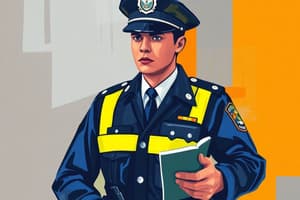Podcast
Questions and Answers
Under which circumstances may a peace officer arrest a person who is found committing a criminal offence?
Under which circumstances may a peace officer arrest a person who is found committing a criminal offence?
- If the officer believes the person is about to commit an indictable offence (correct)
- If the officer has an arrest warrant
- Only if the person is visibly armed
- Only if the person is a known criminal
What is a key factor that must be established for a police officer to continue an arrest without warrant for summary conviction offences?
What is a key factor that must be established for a police officer to continue an arrest without warrant for summary conviction offences?
- The officer must directly witness the offence
- The identity of the person must be uncertain
- The victim must request an arrest
- The public interest must be satisfied (correct)
Which section of the Criminal Code allows any person to arrest without a warrant?
Which section of the Criminal Code allows any person to arrest without a warrant?
- Section 495
- Section 494 (correct)
- Section 497
- Section 525
In what situation may a peace officer not arrest someone without a warrant for an indictable offence?
In what situation may a peace officer not arrest someone without a warrant for an indictable offence?
An officer can arrest a person who has contravened the terms of a criminal release based on which section of the Criminal Code?
An officer can arrest a person who has contravened the terms of a criminal release based on which section of the Criminal Code?
Which criterion does NOT need to be satisfied for a police officer to release an offender unconditionally?
Which criterion does NOT need to be satisfied for a police officer to release an offender unconditionally?
Which of the following statements about the continuation of arrest is accurate?
Which of the following statements about the continuation of arrest is accurate?
What document must a police officer provide if they release someone by way of an Appearance Notice?
What document must a police officer provide if they release someone by way of an Appearance Notice?
What does Section 497 of the Criminal Code primarily address?
What does Section 497 of the Criminal Code primarily address?
What is required for a police officer to enter a dwelling-house to make an arrest?
What is required for a police officer to enter a dwelling-house to make an arrest?
Under what circumstances can police enter a dwelling-house without an entry authorization?
Under what circumstances can police enter a dwelling-house without an entry authorization?
Which of the following is NOT a symptom of excited delirium?
Which of the following is NOT a symptom of excited delirium?
What should officers do to prevent positional asphyxia when restraining a suspect?
What should officers do to prevent positional asphyxia when restraining a suspect?
What responsibility does a police officer have when making an arrest?
What responsibility does a police officer have when making an arrest?
Which statement correctly describes the procedure for handcuffing an individual?
Which statement correctly describes the procedure for handcuffing an individual?
What must police officers announce prior to entering a dwelling for an arrest?
What must police officers announce prior to entering a dwelling for an arrest?
Which of the following is a proper action when an arrested person has a dependent to care for?
Which of the following is a proper action when an arrested person has a dependent to care for?
Which Provincial Statute does NOT provide specific arrest authorities?
Which Provincial Statute does NOT provide specific arrest authorities?
What must be included in the memorandum book when an arrest is made?
What must be included in the memorandum book when an arrest is made?
Which procedure must be complied with when dealing with a person under arrest who has ingested a harmful substance?
Which procedure must be complied with when dealing with a person under arrest who has ingested a harmful substance?
What action should be taken when an arrested person with a guide dog is being considered for continued detention?
What action should be taken when an arrested person with a guide dog is being considered for continued detention?
What should the Officer in Charge ensure when an arrest has been made?
What should the Officer in Charge ensure when an arrest has been made?
Which document must be served to a person when releasing them on either a Form 9 or Form 10?
Which document must be served to a person when releasing them on either a Form 9 or Form 10?
In which situation should an arrest of a foreign national be avoided?
In which situation should an arrest of a foreign national be avoided?
What must be checked if an arrest involves an arrest warrant?
What must be checked if an arrest involves an arrest warrant?
What should be done for an arrested person who has difficulty communicating due to a medical problem?
What should be done for an arrested person who has difficulty communicating due to a medical problem?
What must be recorded in the Unit Commanders Morning Report (UCMR) after an arrest?
What must be recorded in the Unit Commanders Morning Report (UCMR) after an arrest?
When should a person be transported to the hospital after an arrest?
When should a person be transported to the hospital after an arrest?
Flashcards are hidden until you start studying
Study Notes
Arrest Authority
- Section 494 of the Criminal Code (CC) allows for arrest without a warrant by any person.
- Peace officers have additional powers under sections 495(1), 524(2), 525(6), and 31(1) CC.
- Arrest authority for peace officers includes:
- Arresting anyone who has committed or is about to commit an indictable offence.
- Arresting individuals found committing a criminal offence.
- Arresting those wanted on a warrant within the officer's jurisdiction.
- Arresting individuals violating terms of criminal release or committing offences while on release.
- Arresting those breaching the peace.
Continuation of Arrest
- Police cannot arrest for summary or dual procedure offences if public interest is satisfied, which includes:
- Establishing identity.
- Preserving evidence.
- Preventing further offences.
- Ensuring court appearance.
- Protecting victims or witnesses.
- Types of release when public interest is satisfied:
- Unconditional with no intent to proceed.
- Unconditional with intent for a criminal summons.
- Via Appearance Notice (Form 9).
- Arrest may continue if public interest is not satisfied or for specific indictable offences, excluding dual procedure and 553 offences.
Provincial Offences
- Specific provincial statutes, like the Highway Traffic Act, give police authority to arrest but no general power for provincial statute violations.
Arrest in a Dwelling-House (Feeney Warrants)
- Generally, police need a warrant to enter a dwelling for arrests.
- Exceptions where entry is allowed without a warrant include:
- Warrant is endorsed with entry authorization.
- Emergency situations to prevent bodily harm or evidence destruction.
- Fresh pursuit circumstances.
- Mandatory announcement before entry unless immediate announcement would endanger safety or risk evidence loss.
Medical Considerations
- Positional Asphyxia: Restraint positions can compromise breathing. Sit individuals to promote safe breathing.
- Excited Delirium: Symptoms include violent behavior, hallucinations, and heightened strength. Treatment requires medical emergency response.
Race and Identity-Based Data Collection
- Toronto Police Service must collect and report data on race interactions with the public as per Policy 16-07.
Responsibilities of Police Officers During Arrest
- Must identify as a police officer and inform the individual of the arrest reason and rights.
- Required to conduct a Person Query and document all relevant details in the memorandum book.
- Handcuffing is necessary unless justified otherwise considering individual circumstances.
Special Considerations During Arrest
- Must provide reasonable telephone access post-arrest and secure care for dependents if needed.
- If an arrested person poses a medical risk (e.g., intoxication, harmful substance ingestion), immediate medical action is required.
- Must comply with procedures for non-English speakers and consider special accommodations for individuals with disabilities.
Release Procedures
- Ensure safety of both the released person and others at the time of release.
- Service of TPS 493 is mandatory upon release.
Handling Foreign Nationals
- Special issues arise with diplomatic officials’ arrests—embassies are outside local jurisdiction.
Officer in Charge Responsibilities
- Ensure continued detention decision considers public interest factors.
- Complete necessary eReports and document relevant particulars in the Unit Commanders Morning Report (UCMR).
- Ensure compliance with release provisions and proper documentation upon release.
Studying That Suits You
Use AI to generate personalized quizzes and flashcards to suit your learning preferences.




